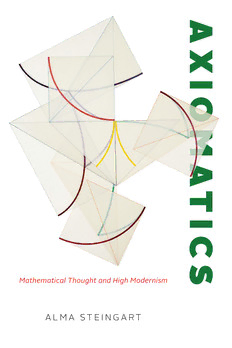
Axiomatics: Mathematical Thought and High Modernism PDF
Preview Axiomatics: Mathematical Thought and High Modernism
Axiomatics Axiomatics Mathematical Thought and High Modernism alma steingart the university of chicago press chicago and london The University of Chicago Press, Chicago 60637 The University of Chicago Press, Ltd., London © 2023 by The University of Chicago All rights reserved. No part of this book may be used or reproduced in any manner whatsoever without written permission, except in the case of brief quotations in critical articles and reviews. For more information, contact the University of Chicago Press, 1427 E. 60th St., Chicago, IL 60637. Published 2023 Printed in the United States of America 32 31 30 29 28 27 26 25 24 23 1 2 3 4 5 isbn- 13: 978- 0- 226- 82418- 5 (cloth) isbn- 13: 978- 0- 226- 82420- 8 (paper) isbn- 13: 978- 0- 226- 82419- 2 (e- book) doi: https://doi.org/10.7208/chicago/9780226824192.001.0001 Library of Congress Cataloging-in-Publication Data Names: Steingart, Alma, author. Title: Axiomatics : mathematical thought and high modernism / Alma Steingart. Description: Chicago : The University of Chicago Press, 2023. | Includes bibliographical references and index. Identifiers: lccn 2022026640 | isbn 9780226824185 (cloth) | isbn 9780226824208 (paperback) | isbn 9780226824192 (ebook) Subjects: lcsh: Mathematics—Philosophy—History—20th century. | Mathematics— United States—History—20th century. | Knowledge, Theory of—United States— History—20th century. | Axiomatic set theory. | BISAC: MATHEMATICS / History & Philosophy | PHILOSOPHY / Epistemology Classification: lcc qa8.4 .S74 2023 | ddc 510.1—dc23/eng20220829 LC record available at https://lccn.loc.gov/2022026640 ♾ This paper meets the requirements of ansi/niso z39.48- 1992 (Permanence of Paper). Contents Note to Readers vii Introduction 1 chapter 1 Pure Abstraction: Mathematics as Modernism 25 chapter 2 Applied Abstraction: Axiomatics and the Meaning of Mathematization 55 chapter 3 Human Abstraction: “The Mathematics of Man” and Midcentury Social Sciences 84 chapter 4 Creative Abstraction: Abstract Art, Pure Mathematics, and Cold War Ideology 116 chapter 5 Unreasonable Abstraction: The Meaning of Applicability, or the Miseducation of the Applied Mathematician 142 chapter 6 Historical Abstraction: Kuhn, Skinner, and the Problem of the Weekday Platonist 171 Epilogue 199 Acknowledgments 211 Archival Collections 215 Notes 217 Index 271 Note to Readers This book is a history of mathematical thought rather than of math- ematics per se. The distinction is an important one, not only because my aim is to trace the history of axiomatic thinking outside of the sole confines of mathematics, but also because I have tried to limit to a mini- mum the mathematical content in the book. The reader does not need to have any prior knowledge of, or even affinity for, mathematics in order to follow the arguments and analysis I make in these pages. The only chap- ter that asks you to follow a mathematical procedure is chapter 1. Here I felt that outlining some of the basic ideas behind the development of algebraic topology was necessary to appreciate the sea change that oc- curred when mathematical texts reversed the relation between structure and content in the 1950s and 1960s. The reader who is strongly averse to mathematics can skip the chapter. Introduction To see things not abstract as if they were. And vice versa. There is no abstraction like the present, and the present is entirely concrete. (False.) Abstraction makes nothing happen. That’s no abstraction, that’s my husband. That’s no abstraction, that’s the symbolic order writ large. — Charles Bernstein, “Disfiguring Abstraction” On the evening of Thursday, December 19, 1946, the great German math- ematician Hermann Weyl, an émigré to the United States, pleaded with eighty of the leading lights of modern mathematics while they were trying to eat their dinner. The room before him was packed with math- ematicians who had descended upon Princeton University three days ear- lier for the first international mathematical gathering since the Second World War’s end. The tone was meant to be triumphant, a return to intel- lectual comity after the ravages of war. Now that the fighting was finally over, mathematicians were eager to celebrate their past achievements and announce the start of a new age of research. Those in attendance fell roughly into three groups. The first included old guard American math- ematicians like Oswald Veblen and Marston Morse, who had worked tire- lessly in the decades before the war to promote research mathematics in the United States and place it on the international stage. The second consisted of European émigrés who poured into the US throughout the 1930s seeking shelter from persecution and the devastation of war (Weyl,
